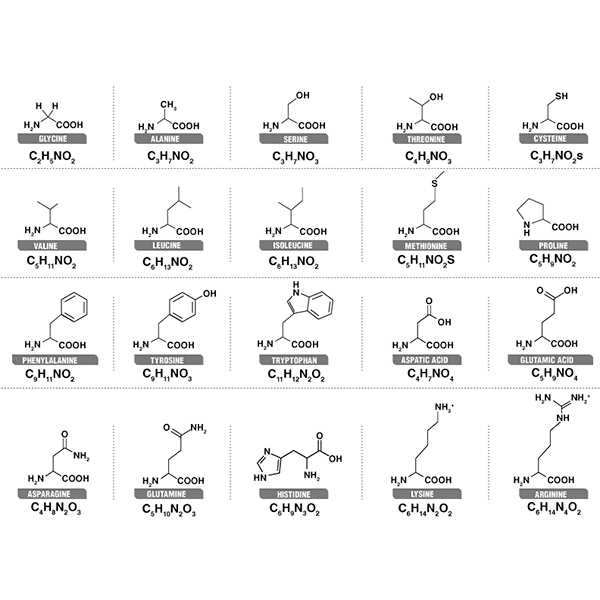A Guide to Amino Acids: Understanding the Building Blocks of Life
Amino acids are a fundamental component of life yet are often neglected in discussions of health and wellness. While you may have heard of the benefits of specific amino acids, you may not have a full understanding of what they are, why they are important, where to find them, and how to achieve a proper balance of them. This guide aims to provide a comprehensive understanding of amino acids, including their definition, categories, and importance.
What are Amino Acids?
Amino acids are organic compounds that consist of an amine, carboxyl, and a side chain. These components are made up of carbon, hydrogen, nitrogen, and oxygen. There are approximately 500 known amino acids, which can be classified in various ways, including by the location of core structural functional groups, side chain group type, polarity, and distribution in protein.

Classification of Amino Acids
Amino acids can be categorized into 13 distinct groups, each with its own unique characteristics:
- Simple Amino Acids (Glycine, Alanine, Valine, Leucine, Isoleucine): These amino acids have no functional group in their side chain.
- Heterocyclic Amino Acids (Tryptophan, Histidine, Proline): These amino acids have a side chain ring that includes at least one atom other than carbon.
- Hydroxy Amino Acids (Serine, Threonine): These amino acids have a hydroxyl group in their side chain.
- Aromatic Amino Acids (Tyrosine, Phenylalanine): These amino acids have a benzene ring in their side chain.
- Sulfur-Containing Amino Acids (Cysteine, Methionine, Homocysteine, Taurine): These amino acids have sulfur in their side chain.
- Amine Group-Containing Amino Acids (Asparagine, Glutamine): In these amino acids, one of the carboxyl groups has been transformed into an amide group.
- Branched-Chain Amino Acids (Leucine, Isoleucine, Valine): These amino acids have aliphatic side chains.
- Acidic Amino Acids (Aspartic Acid, Glutamic Acid): These amino acids have a carboxyl group in their side chain.
- Basic Amino Acids (Lysine, Arginine): These amino acids contain an amino group in their side chain.
- Non-Polar R Group Amino Acids (Aliphatic: Alanine, Valine, Leucine, Isoleucine, Proline; Aromatic: Phenylalanine, Tryptophan, Methionine).
- Polar but Uncharged R Group Amino Acids (Glycine, Threonine, Serine, Tyrosine, Cysteine, Glutamine, Asparagine).
- Negatively Charged Amino Acids (Aspartic Acid, Glutamic Acid).
- Positively Charged Amino Acids (Lysine, Arginine, Histidine).
Importance of Key Amino Acids
Glycine
Glycine is considered one of the key amino acids as it is important for the proper functioning of many physiological processes in the body. It is a non-essential amino acid, which means the body can synthesize it, but it can also be obtained from dietary sources. Glycine is involved in the synthesis of proteins, bile acids, nucleic acids, and other important molecules. It also plays a role in the regulation of muscle contractions and is involved in the regulation of glucose metabolism, making it essential for maintaining energy levels and overall health.
Alanine
Valine
Valine is an essential amino acid that helps to regulate muscle metabolism, providing the muscles with energy and helping to prevent muscle wasting. Valine also promotes normal growth and repair of tissues and helps to maintain a positive nitrogen balance in the body, which is necessary for muscle building. Sources of Valine include meat, dairy, soy, and beans.
Leucine
Leucine is another essential amino acid that is particularly important for muscle growth and repair. It helps to stimulate protein synthesis and has been shown to improve athletic performance and enhance muscle recovery after exercise. Leucine can be found in high concentrations in dairy products, meats, and soy products.
Isoleucine
Isoleucine, like Leucine, is essential for muscle growth and repair. It also helps regulate blood sugar levels and provides energy to the muscles. Isoleucine can be found in dairy products, meats, and soy products.
Tryptophan
Tryptophan is an essential amino acid that is a precursor to the neurotransmitter serotonin, which plays a key role in regulating mood, appetite, and sleep. Tryptophan has also been shown to have a positive effect on anxiety and depression. Sources of Tryptophan include turkey, eggs, cheese, and beans.
MEET OUR ENDOCRINOLOGY & NUTRITION TEAM
- All
- Diet and Nutrition
- Endocrinology
Histidine
Histidine is an essential amino acid that is necessary for the growth and repair of tissues. It is also involved in the production of hemoglobin and helps to regulate blood pH. Histidine can be found in meats, fish, dairy, and grains.
Proline
Proline is a non-essential amino acid that is important for the structure and stability of proteins, particularly in connective tissues such as skin, bones, and tendons. Proline can be found in high concentrations in dairy products, meats, and soy products.
Amino acids play a crucial role in various physiological processes, from muscle growth and repair to neurotransmitter production and regulation of blood sugar levels. It is important to consume a balanced diet that includes a variety of foods that are rich in different amino acids, in order to maintain optimal health and wellness. While some amino acids can be produced by the body, others must be obtained from dietary sources, making it essential to consume a diet that is rich in protein. Want to learn more about amino acids and their role in your diet? Speak to an expert from our Nutrition and Dietetics Clinic in Dubai.
